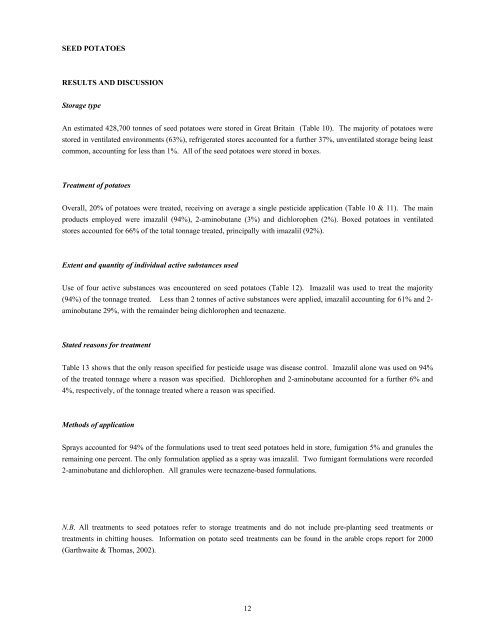Potato Stores in Great Britain - The Food and Environment Research ...
Potato Stores in Great Britain - The Food and Environment Research ...
Potato Stores in Great Britain - The Food and Environment Research ...
Create successful ePaper yourself
Turn your PDF publications into a flip-book with our unique Google optimized e-Paper software.
SEED POTATOES<br />
RESULTS AND DISCUSSION<br />
Storage type<br />
An estimated 428,700 tonnes of seed potatoes were stored <strong>in</strong> <strong>Great</strong> Brita<strong>in</strong> (Table 10). <strong>The</strong> majority of potatoes were<br />
stored <strong>in</strong> ventilated environments (63%), refrigerated stores accounted for a further 37%, unventilated storage be<strong>in</strong>g least<br />
common, account<strong>in</strong>g for less than 1%. All of the seed potatoes were stored <strong>in</strong> boxes.<br />
Treatment of potatoes<br />
Overall, 20% of potatoes were treated, receiv<strong>in</strong>g on average a s<strong>in</strong>gle pesticide application (Table 10 & 11). <strong>The</strong> ma<strong>in</strong><br />
products employed were imazalil (94%), 2-am<strong>in</strong>obutane (3%) <strong>and</strong> dichlorophen (2%). Boxed potatoes <strong>in</strong> ventilated<br />
stores accounted for 66% of the total tonnage treated, pr<strong>in</strong>cipally with imazalil (92%).<br />
Extent <strong>and</strong> quantity of <strong>in</strong>dividual active substances used<br />
Use of four active substances was encountered on seed potatoes (Table 12). Imazalil was used to treat the majority<br />
(94%) of the tonnage treated. Less than 2 tonnes of active substances were applied, imazalil account<strong>in</strong>g for 61% <strong>and</strong> 2am<strong>in</strong>obutane<br />
29%, with the rema<strong>in</strong>der be<strong>in</strong>g dichlorophen <strong>and</strong> tecnazene.<br />
Stated reasons for treatment<br />
Table 13 shows that the only reason specified for pesticide usage was disease control. Imazalil alone was used on 94%<br />
of the treated tonnage where a reason was specified. Dichlorophen <strong>and</strong> 2-am<strong>in</strong>obutane accounted for a further 6% <strong>and</strong><br />
4%, respectively, of the tonnage treated where a reason was specified.<br />
Methods of application<br />
Sprays accounted for 94% of the formulations used to treat seed potatoes held <strong>in</strong> store, fumigation 5% <strong>and</strong> granules the<br />
rema<strong>in</strong><strong>in</strong>g one percent. <strong>The</strong> only formulation applied as a spray was imazalil. Two fumigant formulations were recorded<br />
2-am<strong>in</strong>obutane <strong>and</strong> dichlorophen. All granules were tecnazene-based formulations.<br />
N.B. All treatments to seed potatoes refer to storage treatments <strong>and</strong> do not <strong>in</strong>clude pre-plant<strong>in</strong>g seed treatments or<br />
treatments <strong>in</strong> chitt<strong>in</strong>g houses. Information on potato seed treatments can be found <strong>in</strong> the arable crops report for 2000<br />
(Garthwaite & Thomas, 2002).<br />
12
















